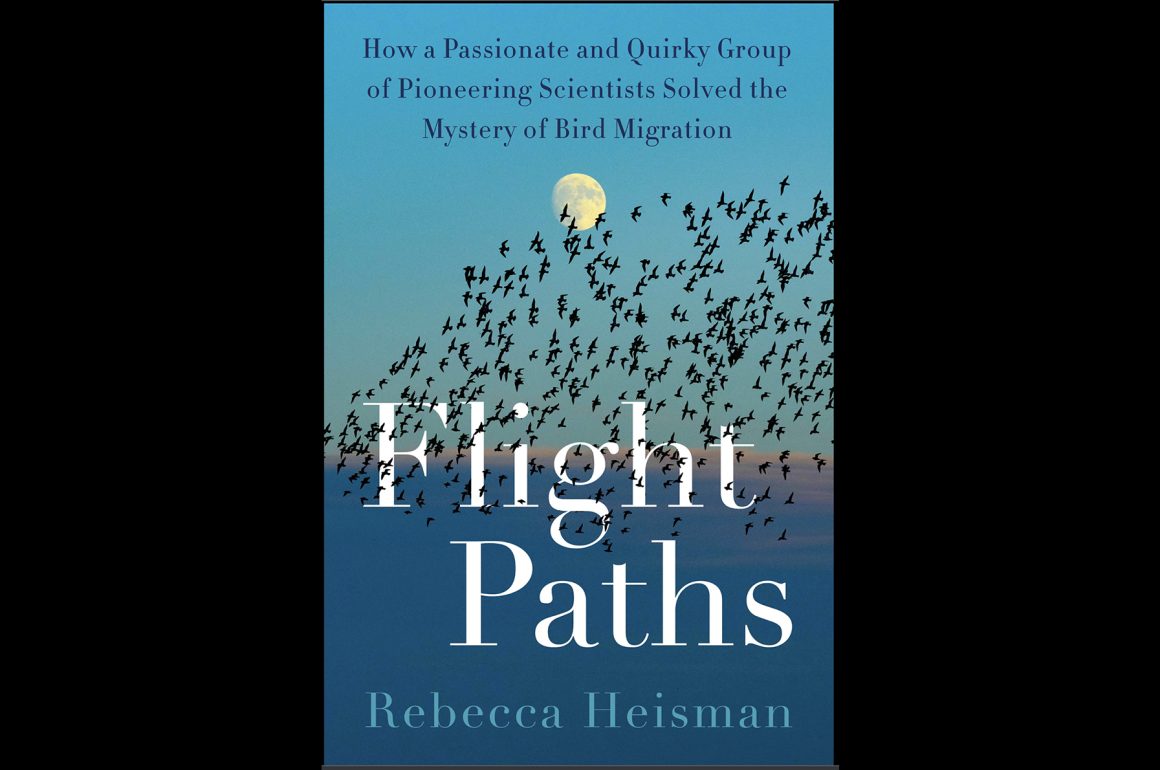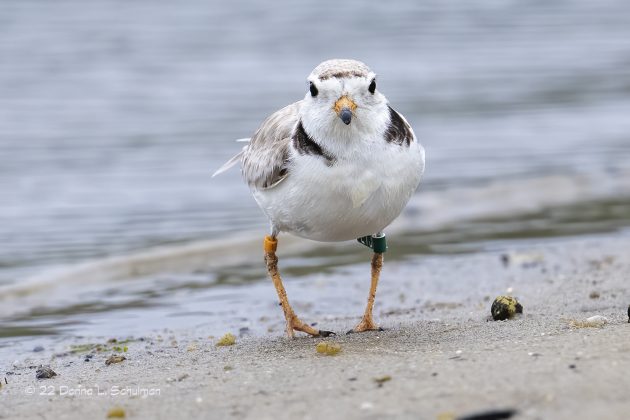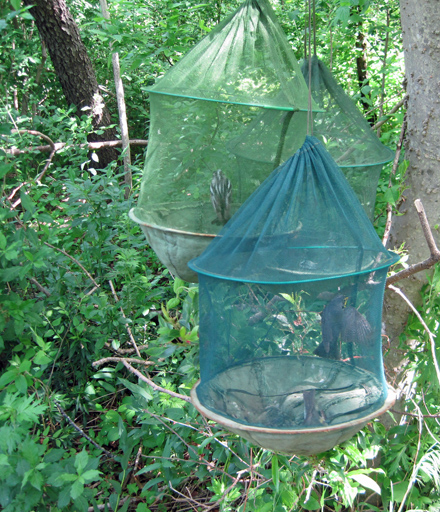
Flight Paths is a splendid but risky title for a book about bird migration. It could easily be mistaken for a book about aviation or space navigation or even a flight simulator game if you don’t read the long, adjective-filled subtitle: How a Passionate and Quirky Group of Pioneering Scientists Solved the Mystery of Bird Migration. I am not sure if this is totally true in the widest sense, especially when it comes to the question of WHY birds migrate (I’m asked this question constantly by beginning birders and would love an answer that doesn’t involve a garble of words about magnetic fields, genetics, and scarcity of resources). Scientists have made some pretty astounding discoveries, however, about the ways in which birds migrate–routes for spring and fall migrations, the astonishing nonstop flights taken by Bar-tailed Godwits and Blackpoll Warblers, the huge numbers of songbirds that migrate at night, the unexpected geographical twists –and have devised creative, ingenious ways to get to these discoveries. Author Rebecca Heisman has crafted a book about bird migration, scientific process, and creativity that’s informative, engaging, and inspiring.
Flight Paths traces the history of migratory research in nine chapters, starting with the earliest attempts to track birds, bird banding/ringing (which she traces back to Audubon), and ending with ‘community science’ projects such as Breeding Bird Surveys and eBird. Chapters in-between cover nocturnal flight research; adapting radar to tracking birds; radio trackers and telemetry; satellite tags (the famous flight of E7, the Bar-tailed Godwit) and GPS devices; geolocators (using the sun with increasingly tiny devices); isotope analysis (looking for deuterium in a feather); and genetic research–applying genomic analysis to feathers and the start of the Bird Genoscape Project. Each chapter is written historically, illustrating the sometimes unexpected ways in which ideas percolate and information travels. The chapter titled “Chasing Angels,” for example, starts with naval officer Irven Buss using his naval ship’s radar to track birds off the coast of China in 1946. The chapter ends in the current day with ornithologists utilizing NEXRAD, Next Generation Weather Radar system–a different, vaster type of radar–to create BirdCast, the user-friendly migration tracking website I look at every night.
A banded Piping Plover I photographed in Southampton, Long Island in June 2023. I sent in the bands’ number and color and found out that it was banded five years earlier in Fire Island. THIS IMAGE NOT IN THE BOOK. © Donna L. Schulman, 2023.
It’s a lot, a lot of research, maverick and institutional, a lot of science spanning ‘pure’ disciplines of biology and zoology and applied disciplines of engineering and computer technology. Heisman smartly ties it all together by focusing on the people. There are some charismatic personalities here, most notably Bill Cochran, the electrical engineer who in the 195o’s jury-rigged a bicycle axle and a reel-to-reel tape recorder for ornithologist Richard Graber, resulting in the first all-night recording of nocturnal flight calls, and who later, in 1973, chased a Swainson’s Thrush fitted with radio transmitters for 930 miles, traveling in an antenna-fitted Chevy station wagon that looked like something out of “Twister” (you know, the film about hurricane chasers). Cochran followed thrushes for 34 years and is now considered one of the founders of wildlife telemetry (instead of patenting his radio transmitters, he gave away his knowledge), but was a scientific outsider for much of his life. His adventures were first documented (to my knowledge) for the birding public in Miyoko Chu’s in Songbird Journeys (2006). Flight Paths gives us another opportunity to get to know Cochran, and Heisman’s visit to his Illinois house in 2021 (during the Pandemic, so everyone was masked) gives us a final, cheery portrait of a man who embraced birds and adventure. He died August 2022, and the book is dedicated to him.
Heisman does an excellent job screen-shotting a panoply of personalities across the ornithological research landscape. Some are portrayed in greater life detail than others but never to the extent that the personality overshadows the science. It all comes together in a rather quilt-like manner. She makes a point of including women who have made life choices, such as Kristen Ruegg, now co-director of the Bird Genoscape Project, ten years ago a postdoc working on analyzing the DNA of Wilson’s Warbler and trying to cover the cost of day care. She also highlights scientists with roots beyond the U.S., such as Ana González, a Colombian-born young ornithologist who used Motus radio telemetry to track wintering thrushes in her home country, assembling two towers (with the help of colleagues) from the electronic components that arrived in boxes and setting up one of those towers on top of a remote mountain.
Heisman writes in the journalist writing style that has become the norm in popular bird books, perfected by writers like Jennifer Ackerman. She reports from her personal point of view and takes us with her as she interviews ornithologists in person or via Zoom, accompanies them in the field (checking rail traps with Auriel Fournier in an Illinois floodplain, for example), or tries a little science on her own, scoping birds, or rather, trying to scope birds, as they migrate against a full moon. She is very good at breaking down complicated scientific concepts like isotope analysis to their simplest components, which I think is a core requirement for good scientific popular writing. She also effortlessly and consistently connects the science to its most important application, conservation. And she is very conscious of the ethics involved in the scientific processes she describes, even interviewing an ethics specialist on whether we should be burdening tiny birds with our scientific apparatus.
Warblers caught in mist nets and placed in net bags, waiting, some impatiently, to be weighed and banded. Photo taken at the Sandy Hook, N.J. banding station, 2020. NOT IN THE BOOK. © Donna L. Schulman, 2010.
Heisman comes by her explanatory writing skills from an academic background in environmental education and four years working in communications for the American Ornithological Association. She has also written articles for Audubon Magazine, including one on birding during the pandemic with a cancer diagnosis, Cornell University’s Living Bird, book reviews for Birding magazine, and blog posts and articles for the American Bird Conservancy. The amount of research she did for this book is mind boggling, especially considering that most of it was during the Covid years. Many of her interviews were done over Zoom, even touring laboratories, with the gracious cooperation of her interviewees. “Bird Twitter” was also an important source; Heisman reports finding key leads via the social media platform. Luckily it was before many bird-oriented writers, students, and scientists, including Heisman, stopped using it on a regular basis.
I was disappointed that Flight Paths does not include a bibliography of sources and interviews. There is a very short list entitled “Further Reading and Resources” that consists of eleven, mostly well-known websites (BirdCast, USGS Bird Banding Laboratory), but no books or articles. Those can be found in the lengthier list of “Notes” that follows but locating them requires work. The Notes document facts, quotes, and sources in the text and are listed by chapter, page and phrase. But there are no indications that these notes exist in the text itself. I wouldn’t have known if I didn’t have the librarian habit of checking out the end of a book first. And reading the table of contents (trust me, most people do not read the table of contents). It’s very frustrating, especially since the citations themselves are expertly written in detailed academic format. There is another nitpick: Chandler Robbins is rightly profiled as the visionary who conceived of and developed the Breeding Bird Surveys (BBS) now carried out by hundreds of volunteers under the aegis of the U.S. Geological Survey. Heisman is admittedly impressed by the breadth of Robbins’ long career but leaves out the accomplishment that most birders remember him for, the classic “Golden Guide,” Birds of North America: A Guide to Field Identification, co-written with Bertel Bruun and Herbert Zim, illustrated by Arthur Singer. Published in 1965, with the latest revised copy issued in 2001, the Golden Guide inspired many birders and is still cited in some circles for its pioneering sonograms and beautiful artwork.
On the plus side, there is a very good index–easy to use, directing the reader to both people and concepts. There is also a 16-page insert of 51 images and photographs, illustrating technology (bird bands, a spectrogram of a nocturnal flight call), people, and birds (a clearly outraged Magellanaic penguin wearing an early geolocation device, a Swainson’s Thrush being fitted with a Motus transmitter). The photographs, many by the author, are credited at the end of the book.
Flight Paths: How a Passionate and Quirky Group of Pioneering Scientists Solved the Mystery of Bird Migration by Rebecca Heisman is an excellent addition to the bird migration bookshelf. You could say that migration is covered by almost any birding book; I learned a lot about radio transmitters from Jonathan Slaght’s Owls of the Eastern Ice (2020) and Alexander Lees and James Gilroy’s Vagrancy in Birds (2022) is almost a textbook on migration theory (especially magnetic fields, not covered in Flight Paths). If we are to look at recent books totally devoted to bird migration, we have a small but mighty collection that includes Scott Weidensaul’s Living on the Wind: Across the Hemisphere with Migratory Birds (1999), A World on the Wing: The Global Odyssey of Migratory Birds (2021), Kenn Kaufman’s A Season on the Wind: Inside the World of Spring Migration (2019), and the previously noted Songbird Journeys: Four Seasons in the Lives of Migratory Birds by Miyoko Chu (2006). Two of these books do cover some of the topics explored in Flight Paths (A World on the Wing and Songbird Journeys).
Flight Paths is unique in its description of migration science and technology as a historic process, propelled by imaginative, brilliant personalities, informed by scientific networks, funded by hundreds of universities and foundations, a process that is always moving forward because of a love of birds and a fascination with the mystery of migration. There are many strands that make up the scientific investigations into the question, “Where do the birds go?” Flight Paths helps us better understand the investigations we encounter or engage in as birders–banding, eBird, Motus towers (becoming increasingly a part of the birding landscape as Pasadena Audubon can attest)–and teaches us about the fascinating investigations going on in laboratories and isolated parts of the world. I do not think we have solved the mystery of bird migration. As Heiman points out herself, there are many migratory species we still know very little about. And there is the big question of WHY do birds migrate, still a bit of a muddle. We have, however, come a very long way from a world where banding was the only way to track a migrating bird. And we are using discoveries about the magnitude and diversity of bird migration to make cases for conserving habitat and darkening our skies. Knowing the history of how that came about enriches our appreciation for our birding colleagues, our collective history, and our birds.
Flight Paths: How a Passionate and Quirky Group of Pioneering Scientists Solved the Mystery of Bird Migration
By Rebecca Heisman
HarperCollins, March 2023, 288 pp.
ISBN: 9780063161146; ISBN 10: 0063161141
$30 (discounts from the usual sources and publisher)















Leave a Comment